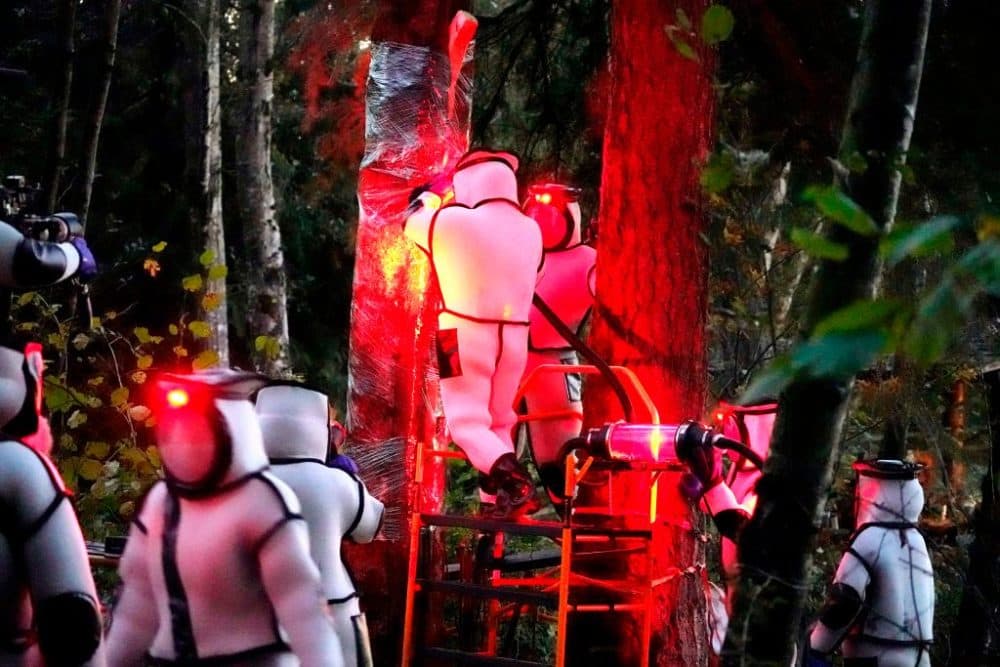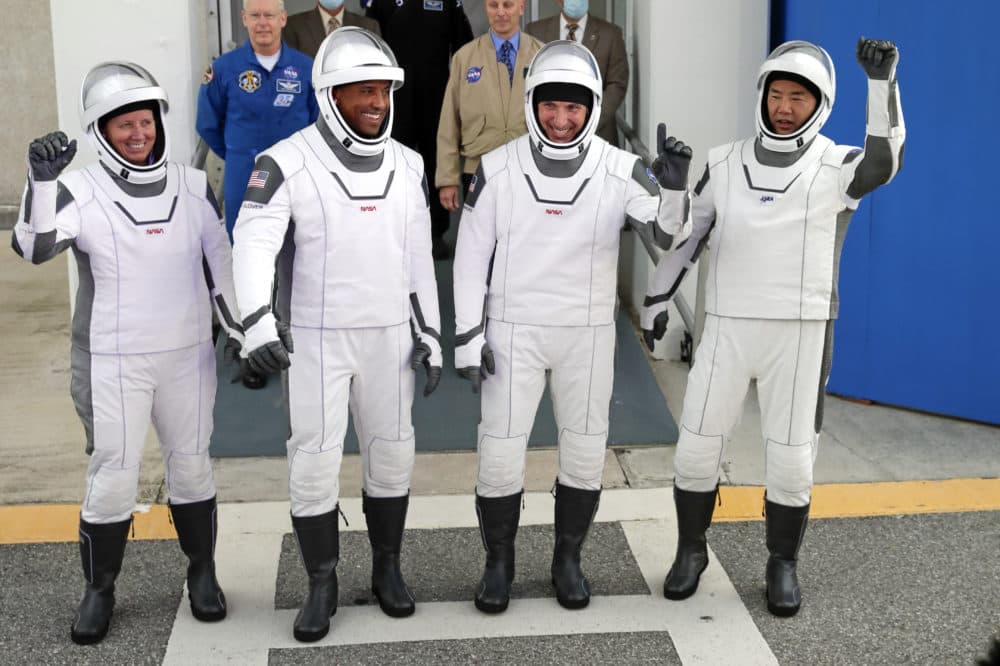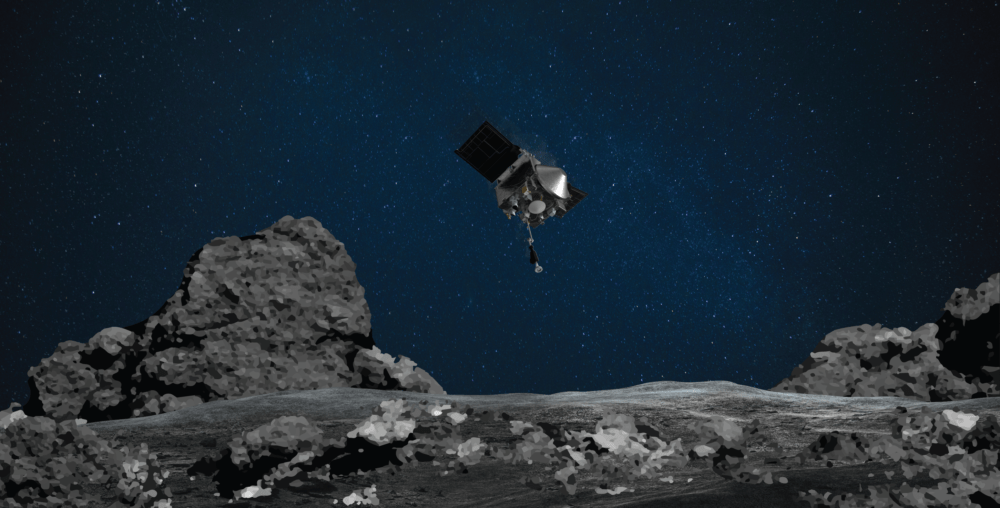Advertisement
From Murder Hornets To Asteroid Samples: The Top Science Stories Of 2020

The coronavirus pandemic has dominated the headlines this year, but there are plenty of other science stories that made waves in 2020.
Since it was a pretty tough year here on Earth, Scientific American editor-in-chief Laura Helmuth says “it’s a really good idea to look beyond our planet” and into space, where a series of scientific breakthroughs took place this year.
Most notably, NASA scientists solved the mystery of fast radio bursts. Researchers have detected the “bright, energetic radio flashes” for about a decade, but they didn’t know where they were coming from, Helmuth says.
“But then this year, they were looking at a dying star, a magnetic neutron star in our own galaxy, and they recorded a signal that looked just like a fast radio burst,” she says. “And so they were finally able to tie these phenomena together and say that fast radio bursts are coming from magnetars, these intensely magnetic neutron stars that are all over the universe.”
Apart from the pandemic, one of the most important stories of 2020 was the outpouring of grief and anger after the killing of George Floyd by police in Minneapolis that reignited a movement for racial justice and equality.
While it doesn’t seem like a science story on its face, Helmuth says “science has been reckoning for a while … with the biases that persist.”
Over the past year, scientific communities from neurologists to engineers to birders came together to highlight systemic racism in the industry and work toward solutions, she says.
“Of course, it's an ongoing project,” she says, “but I think, thanks to the Black Lives Matter movement, I think a lot of people in science are paying more attention and trying to think more actively about how they can fix things.”
Government support for science was also front and center this year due to the pandemic. Scientific American endorsed Joe Biden, marking the first time the magazine has publicly supported a presidential candidate in its 175-year-history.
The endorsement “was based strictly on science issues,” Helmuth says. Scientific American is “relieved” that Biden won the election because it brings an end to the Trump administration’s “catastrophic management of the coronavirus pandemic” and amplification of conspiracy theories about climate change.
Advertisement
“But we do have very high expectations,” she says. “Some of the most urgent issues that [the Biden] administration faces are about science.”
The president-elect has promised to rely on science in his approaches to both the pandemic and climate change, drawing a stark contrast to how Trump dealt with those problems, she says. These are among the two deadliest issues of our time, Helmuth says.
“Trump undid so many good Obama-era attempts to control climate change and protect the environment in other ways, so the Biden administration needs to both clean up the mess that [the] Trump administration made and make up for lost time,” she says. “But he needs to go way beyond that to really start to make a difference on climate.”
More Top Science Stories Of 2020

SpaceX, NASA launch astronauts to the International Space Station for the first time
“Well, it was a big deal that it worked. There was, of course, a little bit of nervousness about that because the private space industry has been developing very quickly. … Experiment quickly, see what works, what doesn't, and sometimes what doesn't work is things blow up on the launchpad. So it was very good news when the astronauts arrived at the International Space Station successfully. … This seems to be the way forward for crude space missions, partly because they're so expensive. It's really hard for NASA to do it on their own, and so they've been creating these partnerships with SpaceX and some of the other private space companies, and it seems like that's where spaceflight is going.”
Japan and NASA embark on missions to study asteroids
“It's been a really good year for asteroids. So Japan's Hayabusa2 mission. It went to an asteroid named Ryugu. It blasted into the asteroid and sent a capsule to scoop up a bunch of dust and rocks and sent it back to Earth. And it landed in Australia, and scientists from Japan's aeronautical administration picked up the capsule, recovered it, brought it back to Japan, opened it up, and it is indeed full of asteroid bits. And one of the reasons that you want to bring back rocks from distant outer space is to understand what the solar system is made out of. What are the basic ingredients of the universe in really pristine asteroids, things that haven't been transformed so much as the rocks on Earth have been?
“And then NASA, it's OSIRIS-REx mission, has been studying an asteroid named Bennu. It's been there for a couple of years, and just this year it popped into Bennu and exploded a bit off of it and scooped up some material from Bennu. And it's going to send that back to Earth. It's working on that now, and we're hoping in 2023 to get a sample of Bennu that we can study.”

Oregon approves ballot measure to legalize psychedelic mushrooms
“The Oregon example is interesting because they specifically laid out a legal framework for legalizing psychedelics for therapeutic use, and not just by [doctors] who do have some access to drugs that otherwise or are controlled, but to set the way for therapists who aren't M.D.s who are treating patients with depression, with post-traumatic stress disorder, dealing with end-of-life care. The evidence just keeps growing.
“Johns Hopkins [University] has a new institute or a new center that's looking at psychedelic drugs and how they can be used therapeutically, and it's been hard to study because the drugs have been so controlled and illegal. But there's more and more evidence that a lot of people are really benefiting from treatment with psychedelics.”
Scientists in Washington state discover invasive murder hornets
“Well, it captured people's imagination. I mean, murder hornets is a great name, but it's scary, just the concept of being bitten by an inch and a half long, you know, the largest hornet in the world. If they should get loose and start stinging people, I mean, it's a really painful bite. So there's that.
“But they're huge and they have these really powerful jaws, and they behead honey bees. They'll go into a hive of honey bees and just chop all their heads off, and so it could be a big problem for the honey bee, for pollination, for honey. We have so many invasive species, and they cause all kinds of problems. We've had die-offs of trees. There's invasive mussels that are disrupting the Great Lakes and new invasive species all the time, but for some reason, murder hornets is the one that's really kind of helped people understand how scary it is to have a new species come in that we have no defenses against that can cause all kinds of pain and destruction.”
Julia Corcoran produced and edited this interview for broadcast with Jill Ryan. Samantha Raphelson adapted it for the web.
This segment aired on December 22, 2020.
